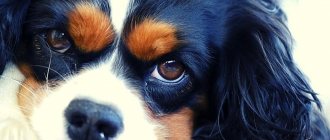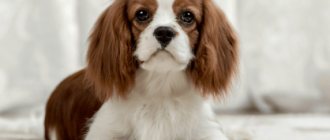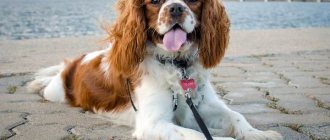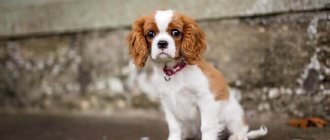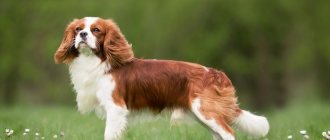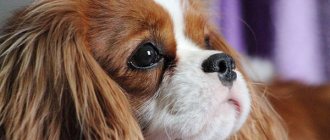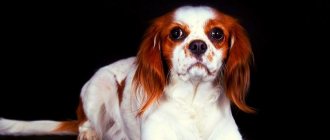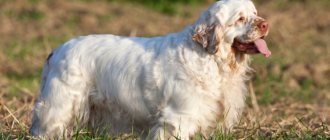Features and description
The Cavalier King Charles Spaniel cannot be called homely She is bright, pretty and memorable. Most owners of such an animal literally dote on it. And this is not surprising. It has an attractive charisma. It is interesting that despite the dog being classified as a spaniel, it is completely devoid of hunting potential.
Aggression is not characteristic of him, as well as well-developed observation and a sense of suspicion. Also, the dog cannot boast of excellent adaptation skills. At first glance, it may seem that these are its shortcomings. In fact, dogs without developed working abilities are excellent companions.
Being close to the owner is the main desire of the Cavalier King. He quickly finds a common language with the person who adopted him, as he is characterized by contact and sociability. He happily gets along not only with the owner-leader, but also with other people. He is very happy when guests come to the house.
The dog's homeland is England. Several centuries ago, only aristocrats could afford to have one. Today the situation is the opposite. Yes, a representative of the breed can hardly be called a cheap pet, but it is accessible to everyone.
Breeders insist that he was bred by crossing Pugs with Spitz and Maltese dogs. It's hard to argue with this, because the standardized Charles King does have the genetic traits of all these dogs. He has established himself as a noble and respectable dog. The mistresses of such a favorite often invited artists to the house so that they could depict them on canvas.
The advantage of such a dog was that it always had a calm disposition and could easily sit on its owner’s legs for several hours. The artist did not have to be angry because the pose of the sitters often changed and he had the opportunity to complete the work on time.
The largest population of such dogs is in the USA. There they were especially loved by retired women. The modern representative of the breed is a frequent guest at exhibitions of decorative dogs, as well as at other events dedicated to animals.
Breed standard
Since royal English families in the 18th and 19th centuries regularly kept Cavalier King Charles Spaniel dogs at court, the behavior of these animals became appropriate. There is no rush or fussiness in their gait, but rather calmness and relaxation.
The representative of the breed is sophisticated and delicate. They classify him as a small dog whose weight should not exceed 7.5 kg. The height at the withers of the dog is from 26 to 30 cm. She has a compact build. The case format is rectangular. Despite having rather short legs, the animal runs quickly, like all representatives of the spaniel group.
His back is very strong and powerful. The strength of these dogs should not be underestimated. They are really hardy. There are no bulges on the body. The lumbar region is poorly expressed. The neck is short, withers are present.
The stomach is tucked up and does not sag. The joints on the paws are well defined, especially the knees. Tail set high. The dog is small, but very fluffy. Against the background of the compact physique, the dog’s head especially stands out.
The forehead line is clearly visible, the skull is convex. Visual feature - the nose at the edge of the muzzle is slightly turned up. Pigmentation is dark. The Charles Spaniel's eyes are large, often with black irises. There are long whiskers on the edge of the dog's muzzle. The huge floppy ears give the breed a special charm. By the way, they have a low rise.
The Cavalier King Charles Spaniel in the photo is a smart, interested and proud dog who will take an interest in everything that happens in the world. He is quite active, inquisitive and purposeful. Such pets have a special charisma, so they always attract attention.
He has straight, long hair, which must have a natural shine. It forms a bright “collar” on the chest. On the ears, back and tail - the longest. Such a dog should not have curls, but on long and large ears the fur may curl slightly.
Popular colors:
- Black, white and red.
- Dark tan.
- Pure brown.
- Black-brown.
- White chocolate.
Individuals with a light shade of fur must have a white spot on the edge of the muzzle. This is an important standardized requirement.
Cavalier King Charles Spaniel
We welcome all Cavalier King Charles Spaniel lovers to our PORTAL!
Dear friends and colleagues! On January 31, the VI National Exhibition of the NCP KKChS “Club Winner 2022” was held in Perm, ending the year. Now we can move on to the main date of the year 2022. This year we celebrate the 35th anniversary of the Cavalier King Charles Spaniels in our country (until 1991, the USSR, then Russia). 35 years is a long story that deserves special attention. In this regard, we have planned several projects about the history and modernity of the breed in Russia, and, of course, about people and dogs. We are implementing some projects on the Internet, others at the VII National Exhibition, which will take place on May 9 this year in Omsk and will be dedicated to the 35th anniversary of the breed in Russia. So, we begin our story from the moment the first representative of the Cavalier King Charles Spaniel breed appeared in the USSR...... 1986 of the 20th century, Moscow, USSR...
News
NKP News:
The procedure for considering applications for organizing and holding a specialized breed ring (specialty) within the framework of an exhibition of CACIB rank or CAC rank IX group
*News archive
New on the portal:
results of special breed exhibitions 2022
announcements of special breed exhibitions
Dear organizers of KKChS monobreed exhibitions and specialty breed rings, if you have agreed on an expert for your event in the NCP, we can post an announcement of the exhibition on the resources of the KKChS NKP.
The requirement for the announcement is information only about the gentlemen’s ring. Send the Cavaliers ring announcement file by email *update archive
about the portal
We present an information Internet portal dedicated to the Cavalier King Charles Spaniel breed. We are pleased to announce that lovers of the CKCS breed in Russia now have their own serious Internet platform. The mission of the Portal is responsible and thoughtful coverage of all aspects of the existence and development of the CKCS breed, uniting breed enthusiasts in order to ensure the future health, stability and viability of the Russian livestock. The purpose of all resources united under the roof of the Portal is the most objective presentation of the most important information regarding the breeding, exhibition and veterinary environment of the breed. We will be glad to welcome all breeders, owners, experts and simply interested parties to our resources. We are also grateful to everyone who, in word and deed, contributed to the birth of the breed Portal and invite all enthusiasts of our beloved breed to take an active part in its further development and turning it into an authoritative and objective Internet resource.
Kinds
This representative of the breed is often confused with his closest brother, the King Charles Spaniel. The separation of the 2 species of these dogs occurred in 1945. It is worth noting that most breeders to this day do not support such a decision. They have a well-founded argument - dogs of both breeds are not much different from each other. Their dimensions and character are almost identical, so there is no good reason to separate them.
Types of purchase
Cavalier King Charles Spaniels come in different colors. You can buy a dog:
- Black with bright tan marks.
- Ruby color.
- Redhead.
- Tricolor (combination of black, tan and piebald).
- Blenheim (there are chestnut spots against the background of the white-pearl shade of the coat).
Puppies are sold by age:
- Two months old.
- 2.5-3 months.
- Four months old.
- 5 month old.
- Six months old.
Depending on the degree of purebredness, you can adopt a dog:
- Show class (the animal fully meets the standards and can take prizes at exhibitions).
- Pet class (there are significant deviations in appearance from the accepted standard, the dog is suitable only as a pet).
- Breeding class (there are minor deviations from the standard, the animal is allowed to be used for breeding).
At point of sale:
- According to an ad on the Internet or in a newspaper.
- From a professional breeder.
- At the pet market.
- In a specialized nursery.
Character
Formidable watchman, ferocious hunter, observant bodyguard - these are epithets that describe working dogs, of which the Cavalier King Charles Spaniel is definitely not included. The nature of the dog in question is exclusively “domestic”, a little pampered and even vulnerable. He can be called a loyal friend to all family members, but as a guard or hunter he is ineffective.
Such a pet is a good companion. It’s a pleasure to spend time with him, anywhere: at home in an apartment, in the yard, outdoors or in a store. By the way, it is great for exhibition events. The dog is photogenic and artistic.
Finding herself the center of attention of a large group of people, she becomes excited and becomes more active, winning the attention of more and more spectators. So as a show dog, a representative of the breed is an excellent option.
She is unlikely to become a nanny for children, since she does not have a high level of responsibility, like, for example, a golden retriever. She will probably be offended if one of the kids gets too excited and hurts her. But, due to the natural lack of anger, he definitely won’t attack. He gets along well with middle-aged children, loves to play tag with them or run after the ball they throw.
There is often a sense of aristocracy in the behavior of this animal. It can be stubborn, especially if it was offended by something the day before. Many people associate this character trait of a dog with the difficulties associated with its training. This is partly true.
Since Charles King is characterized not only by pride, but also by laziness, he may simply not want to learn to follow commands. May growl or strike with teeth if very irritated. But such behavior is very rare for him.
If treated well and affectionately, the dog will be sweet, gentle and very friendly. Moreover, such a kind attitude on his part extends not only to the owners, but also to strangers. The dog is not at all aggressive, so he loves when strangers come into the house.
But excessive pride does not allow her to vigorously express positive emotions at the sight of guests. First, the dog will calmly approach the person who comes in, sniff him, and only then make a warm acquaintance if he doesn’t mind. This is a very calm creature that can not only run around the room playing, but also rest quietly in the middle of the day.
He loves when a person takes him in his arms. Can fall asleep on his feet. The dog is ready to fight for the owner’s attention around the clock. Trying to attract his gaze, he may even do mischief, for example, pull away the car keys or chew his shoes. He gets very upset if the owner is indifferent to him. Distressed by separation from their loved ones, Cavalier Kings even refuse to eat.
Care and maintenance
This dog gets along well with people in the house. It can be placed next to your bed, preparing a comfortable soft lounger. She will not disturb the person sleeping next to her, unless she gets hungry. Also be sure to please your pet with noisy and colorful toys. He'll love a clinking rattle, a rubber duck, or a soft teddy bear.
Also, be sure to provide a litter tray for your indoor dog. Yes, she can and should go to the toilet outside, but if you live in an apartment, then both you and her will be more comfortable if she uses the litter box when needed. It's convenient for everyone. But, do not forget to regularly change the sand in it, otherwise the spread of an unpleasant odor will become inevitable.
Note! A proud Cavalier King Charles Spaniel dog will never share a litter box with a domestic cat. She will probably compete for him and may even start a fight.
If you live with such a dog in a country house, that’s even better. He will definitely enjoy spending a long time outside, especially if there are other animals living in the house. He will happily get along with them, but only if there are no bullies among them.
This animal is unpretentious in care. The only caveat is that it needs to be combed daily. Straight, silky coat is the main advantage of such a dog. In order for it to always remain beautiful, it needs to be combed, but only with a soft comb. This should be done carefully so that the dog does not get hurt. It is important to untangle the fur under his feet well, as this is where he gets most tangled.
Spaniels also need to have their earwax removed weekly. It will accumulate in the ears gradually and lead to inflammation of the canals. To clean the Cavalier King's ears, use ordinary cotton wool.
The animal's teeth should be brushed. It is not necessary to use toothpaste. We advise you to pay attention to his eyes. If there is souring on them, it is better to rinse the dog’s face with water.
Her fur is very soft and shiny. It is not at all necessary to cut it; it is enough to wash it with shampoo and comb it once every 2 months. But, if the dog is playing outside in bad weather, he must be wiped with a wet towel or bathed again.
Caring for such a pet must necessarily include parasite prevention. It is recommended to give it tablets and capsules against fleas and worms. Even if, in your opinion, parasites do not bother your dog, there is definitely a point in taking appropriate medications. Prevention is the best medicine!
And lastly, Charles Spaniels often get cold, even in warm weather. When going for a walk with them in winter, think about insulating them. Don't forget to buy warm clothes for your pet, especially a cotton suit.
Nutrition
It is best your Cavalier King Charles Spaniel puppy natural food from your table. But there is an important nuance here - it must be of high quality and fresh. What foods should he eat every day to gain weight and strengthen his immune system?
- Boiled rice/buckwheat.
- Oatmeal, steamed with milk (can be boiled).
- Raw chicken or turkey meat.
- Chicken or pork liver.
- Dairy products.
- Boiled eggs.
- Lean sea fish.
Meat and milk are the basis of a young dog’s diet. As she grows up, dry food should be gradually added to her food, increasing the amount every week. This will “smooth out” the sharp transition from one nutritional change to another.
You can also always treat an adult representative of the breed to a bowl of meat broth or soup. But, make sure that there are no sharp bones in it, which could easily get stuck in the throat or intestines.
Important! Remember, you cannot feed your indoor dog sweets or smoked foods. Eating such food can cause pancreatitis or gastritis.
Approximate prices
In Russia, the Cavalier King Charles Spaniel breed will cost approximately the following:
- Pet-class puppies without any documents - about 45,000 rubles .
- Breed class with veterinary card, passport - from 71,000 rubles .
- Show class with all documents (veterinary passport, card, pedigree) - from 85,000 rubles .
Breeders and kennel owners sell puppies of this breed for no less than 70,000 rubles . At the pet market and through an advertisement, you can buy a pet for 30,000-40,000 rubles .
Reproduction and lifespan
Every Cavalier King Charles Spaniel breeder should be well aware of all the breed standard requirements. It is important to know that a high-quality representative of this breed must have:
- Short legs.
- Long, low set ears.
- Straight, soft coat that should not curl.
- Snow-white teeth.
- Big black nose.
- Fluffy tail.
- Weight not exceeding 8 kg.
When a Charles Spaniel bitch goes into heat, you should wait a few days. After this, you need to introduce her to a male dog, who will definitely smell the heat. This will be a signal to him that there are favorable conditions for mating.
It is advisable that both the male and the female are mature, but not too old. The recommended age for breeding them is 2.5-7 years. Within a month and a half, the bitch bears offspring. Her puppies are born hairless, but fur appears on their body by the second week of life.
Exterior
Cavalier King Charles Spaniel dogs were very popular back in the Middle Ages among noble people. Today this breed is also relevant. The standard was approved in the late 20s of the last century. But the British Kennel Club approved the breed in 1945.
Appearance description:
- The muzzle is wedge-shaped.
- The eyes are round and large.
- The nose is black, unpigmented.
- Scissor bite.
- The ears are long, hanging, covered with long hair.
- The body is proportional.
- The back is straight.
- The ribs are arched.
- The tail is docked to one third.
- The front legs are straight, the hind legs are bony.
- The coat is thick and silky.
- There is fraying closer to the paws.
On average, representatives of the spaniel breed live about 11 years . But there are also 15-year-old centenarians. By nature, the dogs are soft, calm, flexible, and friendly. They have high intelligence and are trainable.
Price
The cost of these status pets cannot be called low. In prestigious Russian nurseries their price can reach up to 55 thousand rubles. Some champion dogs are sold from 65 thousand rubles.
But, if “pedigree” is a word that doesn’t mean anything to you, we recommend saving money and buying a puppy from a private breeder. The main thing is to make sure that it is well built and looks healthy. The price of a Cavalier Charles King Spaniel from private owners is from 7 to 10 thousand rubles.
Raising and socializing a dog
Let's start with the main thing, representatives of the breed are real fidgets. It is difficult to turn their attention to themselves, especially if they are upset about something. The Cavalier King loves games, especially noisy and active ones, so it is extremely difficult to train him by professionally teaching him traditional dog commands.
That is why the vast majority of owners of such pets, when faced with the slightest difficulties associated with their training, give up this idea. But in vain. When raising and teaching the commands of this dog, you should show persistence and patience. He can even perform in the circus, performing complex acrobatic tricks!
You should start with minimal loads. Stock up on treats to reward your young Cavalier King dog for her efforts. Be sure to praise her, pat her on the head and treat her to delicious food. This will make her interested in the learning process. Never shout at her, so as not to frighten or offend her.
Let the animal get used to your company. Don't push it away if it wants to lie or sit next to you. You can go for a walk together, do household chores, relax and even go to the sea. Such a pet will definitely not cause problems. He is easy to carry in his hands, he rarely gets sick and almost never gets spoiled.
However, there must be rules in the house for him. First, immediately explain to the dog that stealing food from the table will result in punishment (verbal reprimand or removal from the room). Secondly, he should also be punished for growling at household members. And thirdly, demonstrate to him that small children and animals are his friends, not enemies. Be present while they meet.
Possible diseases and methods of treating them
Unfortunately, these adorable little dogs often suffer from eye and ear problems. For example, they may develop otitis media or cataracts. In this case, the disease must be treated by a veterinarian. Be sure to take your pet to him for an appointment.
Also, Cavalier King Charles Spaniels often suffer from helminthic infestations, especially if they are not fed correctly. In this case, anthelmintic drugs help. The dosage of the medicine is determined by the doctor examining the animal.
Some representatives of the breed are faced with such unpleasant and dangerous diseases as cancer or dysplasia. In this case, you also cannot do without professional help. Infectious diseases are extremely undesirable for indoor dogs. They are easy to “catch” in winter, especially with weakened immunity. The best prevention is timely vaccinations.
What does the price depend on?
A person who wants to purchase a Cavalier King Charles Spaniel puppy is faced with the fact that the price of the dog differs at different points of sale. When setting prices, breeders take into account a number of factors:
- How many months is the puppy?
- Does he have a pedigree?
- What is your state of health?
- What is the color of the animal.
- Have all vaccinations been completed?
- Do you have a veterinary card and passport?
- Did the puppy’s parents take prizes at shows?
- What is the purchasing method?
- In what region is the sale taking place?
